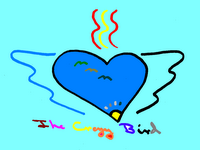 The Danish island of Bornholm is a ship of rock forever sailing the Baltic Sea.
The Danish island of Bornholm is a ship of rock forever sailing the Baltic Sea.Created by tectonic forces hundreds of millions of years ago and shaped by grinding glaciers of the Ice Ages, geologists say that that this Danish island origniated far south of where it is now, more or less equidistant from Sweden, Denmark and Germany.
The longest distance you could go in a straight line on Bornholm would be about fifty miles from the sand and dunes of Dove Point at the south-west corner to the rugged rosy-granite of Gudhjem at the northeast.
The first time I visited the island was in 1970 when I was engaged to play at a restaurant in the harbor town of Gudhjem. The owner of the restaurant was an admirer of the painter Oluf Hoest and played for me a tape where Hoest refered to Bornholm as this "holy island".
It takes more to make a place "holy" than to call it that, but there is a certain ambience to this island of farmers and fishermen is peppered with landmarks bearing place names like: "Gates-of-heaven", "Heavens Gate", "Sacred Cliffs", "St. John's Chapel", and so on. It's the granite rocks of Gudhjem, rosy-red in morning sun where the painter Hoest lived and the experience that summer morning as I sat by the harbor watching the sunrise to which these lines refer:
Between the dawn and day, there is a place where I would stay,
Where rosy-granite rocks are washed today by salty spray.
But you won't find it on a map or in these words I say...
By the way, the name "Gudhjem" translates litereally to "God-home"
Some thirty years later I once again visited Bornholm and by a sort of chance also saw the Round Church at Oesterlars.
There are seven of these strange, barrel shaped, churches in Denmark and four of them are on Bornholm. They look like squat, whitewashed silos, topped by conical, black roofs, made of shingles.
The one at Oesterlars is the largest and most "famous".
Fame, alas, also means being visited by large numbers of tourists; which in turn means it costs a dollar to get in.
If it costs money, I will normally not enter a church building -- I once drove twenty-five miles with my son, David, to see the Cathedral in Roskilde and turned around and went back home when I found we had to pay fifty cents a head to enter.
Sunflower Woman thinks me silly in this -- and since she has put up with me for so many years, I guess it is her privilege.
The reason I won't pay money, is that I never go into a place of religious pratice without trying to sense something of the purpose to which it is dedicated, I hope to let the surroundings call forth that particular flavour and ambience of worship associated with the place.
Despite my ornery stubborness, I got to see the church at Oesterlars. Our daughter Sandra Rose was with us and she got the tickets without my having to notice it too much, or having to fork over the money or even handle the tickets.
I'm glad I got to go into the church. However, my critique was correct -- when tickets are taken, the atmosphere becomes a little like going into a movie theater.
When people pay money, they lose respect and think they have "rights".
Of course, they put up signs reminding people that it is a "place of worship". This helps as much as signs telling to not litter the beach -- that is to say some, but not much.
The inside the church is dominated by an enormous hollow pillar which curves down from the domed ceiling.
The circular floor space inside the pillar at Oesterlars is about nine feet across and the top of the domed ceiling under the pillar is of about the same height. Six gothic archways, spaced equidistantly, grant entrance to the inside of the pillar and give it an open feeling.
On the floor, in the center of the pillar, is a large baptismal font, carved from a single piece of granite. I sat for a while on one of the six stone benches next to the wall inside the pillar. I noted that the baptismal font rested on a brick footing in the shape of a cross which matched the cross formed by the pattern of bricks masonried into the ceiling.
As I sat there soaking up the ambience, I realised that there was something quite clever about the structure of this church. I wondered if it was consciously designed to generate a spiritual understanding a bit different from that of a cathedral and my thoughts turned to the sweat lodge ceremony participated the year before.
I recalledthe aspects of purification, of birth and rebirth, of entering the womb of Mother Earth and being reborn which are at the essence of that sacred ceremony.
I felt something similar there, sitting on the stone bench in the round church.
There is no simple way to know if there is any basis to the intuition. However, the outside of the pillar in the round church was originally covered with paintings.
This was quite common in Danish churches up until the time of the Reformation when they were painted over and forgotten until recently when they were discovered and carefully restored where possible.
The paintings on the outside of the pillar of the church at Oesterlars represent the Jesus story from conception and birth to crucifixion and death, resurrection and final judgement.
Whatever the actual intentions of those who designed the church (and remember, those who create also use intuition at least as much as conscious design!), I have never been in a church where baptism -- which as we know represents death and rebirth into spiritual life -- is so dominating.
What would it be like to be present in this church during a baptism, I can only guess. Moved to tears of sorrow as always, I suppose.
Love being aware.





No comments:
Post a Comment